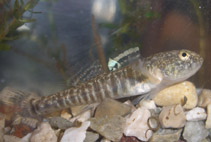http://www.fishbase.org/Summary/speciesSummary.php?genusname=Knipowitschia&speciesname=punctatissima ---> http://192.134.151.83/Summary/speciesSummary.php?genusname=Knipowitschia&speciesname=punctatissima
http://192.134.151.83/Summary/speciesSummary.php?genusname=Knipowitschia&speciesname=punctatissima ---> https://fishbase.mnhn.fr/Summary/speciesSummary.php?genusname=Knipowitschia&speciesname=punctatissima
https://fishbase.mnhn.fr/Summary/speciesSummary.php?genusname=Knipowitschia&speciesname=punctatissima ---> https://fishbase.mnhn.fr/summary/Knipowitschia-punctatissima.html
Knipowitschia punctatissima, Italian spring goby

You can
sponsor
this page
Common name (e.g. trout)
Genus + Species (e.g. Gadus morhua)
-

-
About this page
-
Languages
-
User feedbacks
-
Citation
-
Uploads
-
Related species
-


 Italian spring goby
Upload your
photos
and
videos
Italian spring goby
Upload your
photos
and
videos
Pictures
|
Google image
 Knipowitschia punctatissima
Knipowitschia punctatissima
Picture by
Sanna, F.
Teleostei (teleosts) >
Gobiiformes
(Gobies) >
Gobiidae
(Gobies) > Gobionellinae
Etymology:
Knipowitschia:
Because of N.M.Knipowitsch, a zoologist and Russian ichthyologist from the Academy of Sciences. Expeditions in "Pomor" and "Pervosvanniy" ships to Azov and Black sea (1898-1908)
.
Environment: milieu / climate zone / depth range / distribution range
Ecology
Freshwater; demersal. Temperate; 47°N - 44°N
Europe: Italy and Croatia (Ref.
26100
) and Slovenia (Ref.
119201
).
Size / Weight / Age
Maturity: L
m
?
range ? - ? cm
Max length : 4.5 cm SL (female)
Short description
Morphology
|
Morphometrics
Dorsal
spines
(total): 8;
Dorsal
soft rays
(total): 7-8;
Anal
spines
: 1;
Anal
soft rays
: 7;
Vertebrae
: 31. This species is distinguished from its congeners by the following characters: no head lateral line canals; scales only under pectoral; body of live breeding males with 10-15 dark, irregular bars; D1 7 rays, D2 8.5 branched rays, A 7-8.5 branched rays (Ref.
59043
); interorbit with uniserial row of papillae flanking each orbit (Ref.
12215
).
A short-lived species (less than 2 years) which occurs in small and karstic springs and streams, densely vegetated channels and slow-flowing streams (Ref.
59043
); with constant water temperature, on sand or gravel with or without vegetation, also in silty areas, provided that the water remains clear (Ref.
26100
). Feeds on small invertebrates. Spawns after first winter (February-July); females may spawn more than once during this season. Males defend the eggs deposited in cavities under stones, plant material or shells. Postlarvae pelagic. This species is threatened by water abstraction, which lowers the water table and habitat destruction caused by desiccation of some springs (Ref.
59043
).
Life cycle and mating behavior
Maturity
|
Reproduction
|
Spawning
|
Eggs
|
Fecundity
|
Larvae
Females may spawn more than once during a season (Ref.
59043
).
Miller, P.J.
, 1990. The endurance of endemism: the Mediterranean freshwater gobies and their prospects for survival. J. Fish Biol. 37(Suppl.A):145-156. (Ref.
12215
)
IUCN Red List Status (Ref.
130435
)
Near Threatened (NT)
; Date assessed:
31 January 2006
CITES
Not Evaluated
Not Evaluated
Threat to humans
Harmless
Human uses
Fisheries: of no interest
FAO - Publication:
search
|
FishSource
|
More information
Countries
FAO areas
Ecosystems
Occurrences
Introductions
Stocks
Ecology
Diet
Food items
Food consumption
Ration
Common names
Synonyms
Metabolism
Predators
Ecotoxicology
Reproduction
Maturity
Spawning
Spawning aggregation
Fecundity
Eggs
Egg development
Age/Size
Growth
Length-weight
Length-length
Length-frequencies
Morphometrics
Morphology
Larvae
Larval dynamics
Recruitment
Abundance
BRUVS
References
Aquaculture
Aquaculture profile
Strains
Genetics
Electrophoreses
Heritability
Diseases
Processing
Nutrients
Mass conversion
Collaborators
Pictures
Stamps, Coins Misc.
Sounds
Ciguatera
Speed
Swim. type
Gill area
Otoliths
Brains
Vision
Tools
E-book
|
Field guide
|
Length-frequency wizard
|
Life-history tool
|
Point map
|
Classification Tree
|
Catch-MSY
|
Special reports
Check for Aquarium maintenance
|
Check for Species Fact Sheets
|
Check for Aquaculture Fact Sheets
Download XML
Summary page
|
Point data
|
Common names
|
Photos
Internet sources
AFORO (otoliths) |
Aquatic Commons
|
BHL
|
Cloffa
|
BOLDSystems
|
Websites from users
|
Check FishWatcher
|
CISTI
|
Catalog of Fishes
:
genus
,
species
|
DiscoverLife
|
ECOTOX
| FAO - Publication:
search
|
Faunafri
| Fishipedia |
Fishtrace
| GenBank:
genome
,
nucleotide
|
GloBI
|
Google Books
|
Google Scholar
|
Google
| IGFA World Record |
MitoFish
|
National databases
|
Otolith Atlas of Taiwan Fishes
|
PubMed
| Reef Life Survey | Socotra Atlas |
Tree of Life
| Wikipedia:
Go
,
Search
| World Records Freshwater Fishing |
Zoological Record
Estimates based on models
Phylogenetic diversity index (Ref.
82804
): PD
50
= 0.5000 [Uniqueness, from 0.5 = low to 2.0 = high].
Bayesian length-weight: a=0.00977 (0.00442 - 0.02163), b=3.05 (2.86 - 3.24), in cm total length, based on LWR estimates for this (Sub)family-body shape (Ref.
93245
).
Trophic level (Ref.
69278
): 3.5 ±0.37 se; based on food items.
Resilience (Ref.
120179
): High, minimum population doubling time less than 15 months (Preliminary K or Fecundity.).
Fishing Vulnerability (Ref.
59153
): Low vulnerability (10 of 100).
Back to Search
Random Species
Back to Top
Accessed through:
Not available
FishBase mirror site :
localhost
Page last modified by :
mrius-barile
- 20 July 2016
Fatal error
: Uncaught ArgumentCountError: Too few arguments to function checkEcotox(), 1 passed in /var/www/html/summary/speciessummary.php on line 2304 and exactly 3 expected in /var/www/html/includes/speciessummary.lib.php:2579 Stack trace: #0 /var/www/html/summary/speciessummary.php(2304): checkEcotox() #1 {main} thrown in
/var/www/html/includes/speciessummary.lib.php
on line
2579
|